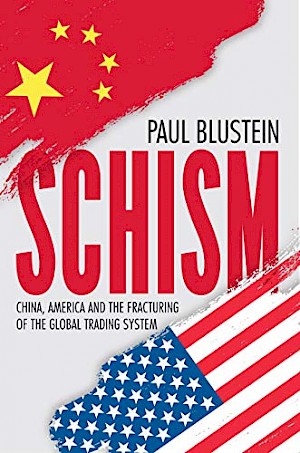23 July 2020
Schism
China, America and the Fracturing of the Global Trading System
Paul Blustein
2019, CGI Press, 280 pages,
ISBN 9781928096-85-6
Reviewer: Rebecca Harding

Paul Blustein’s book is a comprehensive overview of why the world trade system has ended up at a point of Schism between two systems: China’s state capitalism on the one side, and America’s free market capitalism on the other. It tracks China’s accession to the World Trade Organisation and how institutional and political decisions on both sides led both to the immense acceleration in China’s power and, more ominously, to potential fatal blows to multilateralism by 2019.
Much of the history of China’s fifteen-year accession to the WTO, and then its growth within its framework, are well known. This is an experience-based chronological interpretation of what happened during that period ranging from China’s willingness to use the structures of an international rules-based system when it first joined to the accusations of unfairness in the interpretation of those rules now by the current US administration. Its central theme is that China’s power presents a challenge to the rules-based trading system that the WTO represents, as well as to broader institutions around it like the IMF. Because of this challenge, the multilateral system itself should be able to deliver a much more powerful response than it has been able to thus far and that “Trump-style bullying” is not the answer.
What is interesting about this book is the level of detail within each of the stages it describes. The author has spent a great deal of time in China and so charts the evolution of the relationship between it and the WTO with real clarity from the enthusiastic WTO “trivial-pursuit” type competitions in China that attracted 5 million entries, through currency manipulation and the IMF to the under-current of perceived intellectual property theft as China grew and learned from its inward investors. It looks at the effectiveness of the WTO dispute resolution mechanisms, trade remedies and anti-dumping actions; it notes a general dissatisfaction with the WTO leading to the Trans-Pacific Partnership that explicitly excluded China alongside the “pivot” of US Asia-Pacific strategy under the Obama administration.
The book is not neutral. It supports multilateralism and the WTO but on unwaveringly pro-Western capitalist grounds. It says the current situation (as of mid-2019) is “ominous” because China needs to be brought under control, but cites a previous US trade representative who argued, “China likes to have it both ways.”
Without knowing it, the author thus highlights the real unanswered question in the book: how can an increasingly zero-sum approach taken by the US in particular answer the more nuanced and strategic approach that China takes – where the end-game is influence and power, but not necessarily winning; where the conflict is an economic but not a military one - in short, playing a strategic game of “Go” rather than the US game of chess. For example, Made in China 2025 is, by the author’s own admission, not seen in China as a means of creating world dominance but is instead a very real desire to be sure of its security, energy, medicine and food supplies in the event of a global crisis. How much does the “West” need to re-assess its views on this given the retreat to nationalism on exactly the same grounds post-covid?
This is, of course, a rhetorical question. The further breakdown in the relations between the two super-powers since the book was written, and of course the marked change in China’s approach to Hong Kong, Taiwan and to retaliatory action through trade and sanctions if nations disagree with it, does not help the cause of multilateralists who want to bring the two sides closer together. For the author, the resolution is greater authority on the part of a reformed WTO, but trade negotiations now take place outside of the WTO and its appellate body is now not quorate.
Yet as is pointed out, “China’s political and economic system is not about to change in fundamental ways, nor is the US political establishment about to alter its conclusion that China is America’s most formidable strategic rival.” Indeed, Joe Biden’s campaign for election in the autumn is as vocally anti-China as is Trump’s, even if the language is slightly more globalist. This is more ominous than the rise of China’s power or the increasing belligerence of the US administration. The WTO is to the current Trade War as the League of Nations was to the inter-war period. In the words of Paul Blustein, rather poignantly in the penultimate chapter, “Tell me how this ends.”
